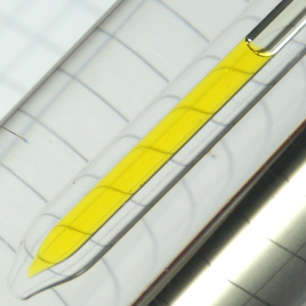Chlorine
| EPA Maximum Residual Disinfectant Level (MRDL) |
4 mg/L |

Liquid chlorine.
Chlorine is a chemical element with a wide range of uses in industrial and consumer products. It's used in plastic manufacturing, dry cleaning, metal degreasing, textiles, agriculture, pharmaceuticals, insecticides, dyes, household cleaning products, and it is an essential reagent in the chemical industry. Chlorine compounds are commonly used in swimming pools to keep them clean and bacteria-free.
Chlorine is the most commonly used water disinfectant, and it is usually the chemical of choice for treatment of hydrogen sulfide, iron, and manganese. Since the early 1900s, it has been the preferred disinfectant for most public water suppliers.
Health Effects of Chlorine
Chlorine can be a potent irritant to the skin, eyes, upper respiratory tract, and lungs.
It can have toxic effects at high concentrations, the EPA reports:
…mild mucous membrane irritation at 1 to 3 ppm; chest pain, vomiting, dypsnea, and cough at 30 ppm; and toxic pneumonitis and pulmonary edema at 46 to 60 ppm.
Although chlorine itself is not a known carcinogen, studies have shown an association between the byproducts of chlorination and bladder and rectal cancer.
Water Treatment for Chlorine
Chlorine is relatively easy to remove. The most common and effective treatment is carbon filtration. Most carbon filters, even the small inexpensive ones, do a decent job of chlorine removal. KDF, a redox medium used in shower filters and drinking water filters, is also an effective and long-term chlorine reducer.
Sources: EPA, WHO, Wikipedia, Photo: images-of-elements.com
Site Index
Filtration Systems
- Aeration for Iron & Sulfide
- Backwashing Filters
(whole house & well units)
- Chlorine & Chemical Injectors
- Countertop Water Filters
- Emergency Filters
- Garden Hose Filters
- Reverse Osmosis, Residential
- Reverse Osmosis, Commercial
- Shower Filters
- Specialty Filters
- Ultraviolet Systems
- Undersink Filters
- Water Softeners
- Whole House Filters
Cartridges
Parts
- Replacement Parts
- Faucets
- Filter Media
- Fittings
- Housings
- O-rings
- Pumps
- Pura UV
- R.O. Parts
- R.O. Tanks
- R.O. Booster Pump
- VIQUA UV